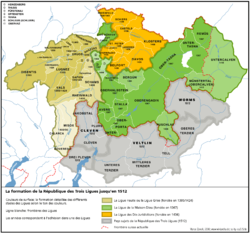League of the Ten Jurisdictions
League of the Ten Jurisdictions | |||||||||
|---|---|---|---|---|---|---|---|---|---|
| 1436–1799 | |||||||||
 The League of the Ten Jurisdictions is shown in orange within the Three Leagues. The Grey League is shown in shades of brown, the League of God's House in green and subject territories, subsequently lost, in grey. | |||||||||
| Status | Associate of the Old Swiss Confederacy | ||||||||
| Capital | Davos | ||||||||
| Government | Republic | ||||||||
| Historical era | Middle Ages | ||||||||
• League of the Ten Jurisdictions founded | 1436 | ||||||||
• Eight Jurisdictions ally with the League of God's House | 1450 | ||||||||
• Alliance with the Grey League | 1471 | ||||||||
• Bundesbrief constitution for the Three Leagues | September 23, 1524 | ||||||||
• All Ten Jurisdictions free from Austria | 1649–1652 | ||||||||
• Annexed to the Helvetic Republic | April 21, 1799 | ||||||||
| |||||||||
The League of the Ten Jurisdictions was the last of the
History
The League of the Ten Jurisdictions was the last of the three leagues to be founded. On April 30, 1436, the last
The first leader of the League was Ulrich Beeli, the Landamman from Davos,[2] and all future Bundstage (Council Meetings) occurred in Davos. The League quickly tied itself to the other surrounding leagues. Within one year (1437) eight of the members of the League had already allied with the League of God's House. The entire League allied with the League of God's House by 1450.[3] In 1471 the League allied with the Grey League, forming the Three Leagues.
Soon after the death of the Toggenburgs, the League was not able to prevent the Court and Judgement rights from being split up and given to local nobles.[2] Although the members of the League had control over the local administration and local politics, they did not have control over High Justice and taxes or levies.
Most of the League was given to Wilhelm,
The League of the Ten Jurisdictions was very active in the Three Leagues after 1471. After 1486 troops from the League participated in military action with the rest of the Three Leagues. In 1524, the League of the Ten Jurisdiction signed the Bundesbrief, which created the Three Leagues. However some of the rights within the Ten Jurisdictions were still held by other noble families. For example, the Baron von Brandis held Maienfeld, which was a member of the League. In 1509 the Baron von Brandis separated the community of Maienfeld from his holdings, and transferred it to the emergent Three Leagues. Maienfeld became a Vogtei of the Leagues. This meant that Maienfeld was both a voting member of the League of the Ten Jurisdictions and under the control of the Three Leagues at the same time. Maienfeld indirectly administered itself as a controlled territory of the Three Leagues.
The rights to High Justice were held by the Dukes of Austria, until the League bought these rights from the duke in 1649–1652. It is only after this date that the League could fully participate in the Three Leagues.[1]
Three Leagues
After about 1471 the three separate Leagues were allied together as the Three Leagues. The Bundesbrief of September 23, 1524 created a constitution for the Three Leagues that would remain until the
The Three Leagues were normally allied with the
See also
- Three Leagues
- Graubünden
References
External links
- League of God's House in Romansh, German, French and Italian in the online Historical Dictionary of Switzerland.
- Grey League in Romansh, German, French and Italian in the online Historical Dictionary of Switzerland.
- League of the Ten Jurisdictions in Romansh, German, French and Italian in the online Historical Dictionary of Switzerland.
- Graubünden in Romansh, German, French and Italian in the online Historical Dictionary of Switzerland.


